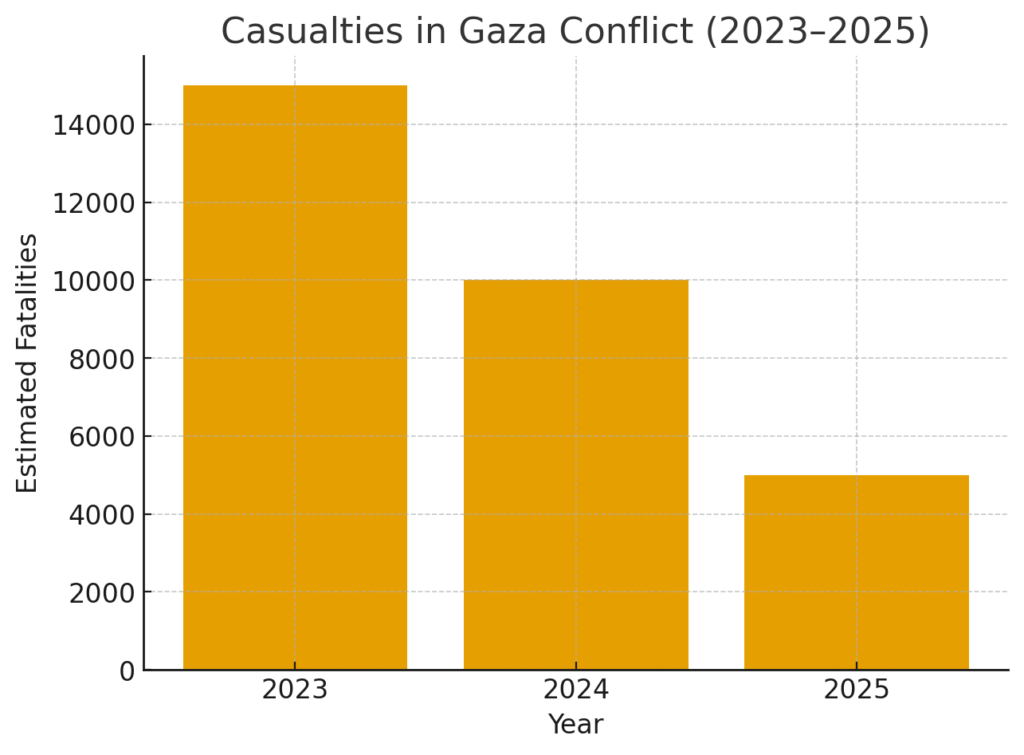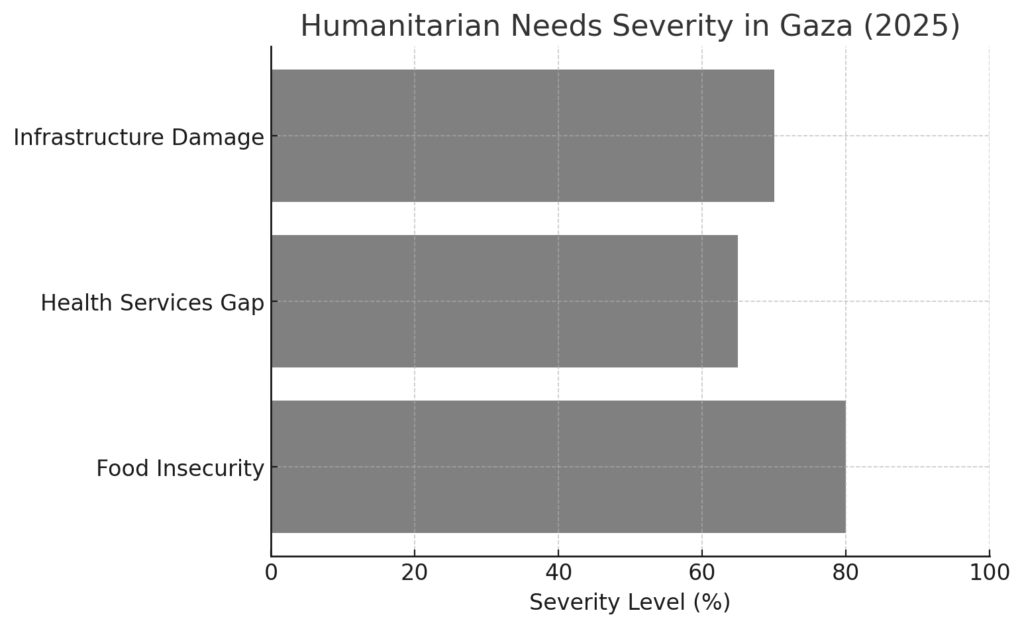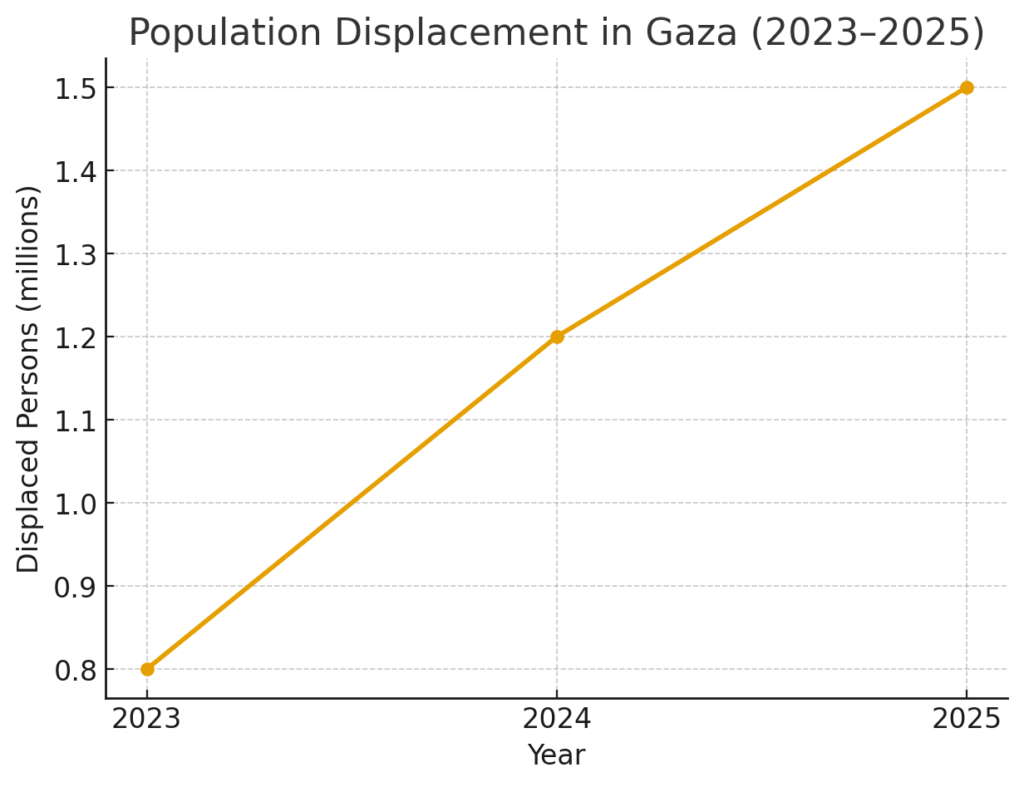Israel and Hamas: First Phase of Gaza Peace Plan
October 2025
Executive Summary
On October 9, 2025, Israel and Hamas agreed to the first phase of a U.S.-backed peace plan aimed at halting hostilities in Gaza. This brief analyzes the terms of the agreement, its humanitarian and political implications, and the risks to successful implementation. While the first phase offers immediate relief—through prisoner exchanges, military repositioning, and expanded humanitarian access—critical challenges remain regarding governance, compliance, and the transition to long-term stability.
Background & Context
The Israel–Hamas conflict has persisted for decades, punctuated by cycles of violence. The most recent escalation (2023–2025) has been among the deadliest, producing:
- Over 30,000 fatalities in Gaza (UN OCHA, 2025).
- Large-scale displacement, with more than 1.5 million Palestinians forced from their homes.
- Humanitarian collapse, with widespread famine conditions, water shortages, and damaged infrastructure.
Diplomatic efforts by Qatar, Egypt, and Turkey—backed by the United States—culminated in this phased peace plan, marking the first substantive agreement since the outbreak of hostilities in late 2023.
Key Provisions of the Agreement
The first phase focuses on immediate, tangible measures designed to build confidence:
- Captive and Prisoner Exchange: Release of 20 Israeli captives in exchange for approximately 2,000 Palestinian prisoners.
- Military Repositioning: Israel will withdraw its forces to an “agreed line” within Gaza, reducing direct confrontation.
- Humanitarian Aid Surge: Expanded access for international agencies to deliver food, medical supplies, and fuel.
- Timeline: Implementation is expected within 72 hours of activation.

Humanitarian and Strategic Dimensions
Humanitarian Impact
- The agreement is expected to improve immediate conditions for civilians, especially through the aid surge.
- However, Gaza’s infrastructure remains devastated, requiring long-term reconstruction efforts estimated at $20–25 billion (World Bank, 2025).
Strategic Considerations
- Arab mediators stress that the end goal must include Palestinian statehood, while Israel insists on dismantling Hamas’s military capacity.
- The U.S. and European partners view the deal as a first step toward broader regional stabilization.
- Hamas has opposed suggestions of international trusteeship, underscoring enduring political divides.
Risks & Challenges
- Lack of Enforcement Mechanisms
- Without independent monitoring, compliance with prisoner releases and military withdrawals could falter.
- Governance of Gaza
- Postwar administration remains unresolved. Options include the Palestinian Authority, a technocratic administration, or an international oversight body—each facing legitimacy challenges.
- Political Spoilers
- Hardliners on both sides, as well as external actors such as Iran and Hezbollah, may undermine progress.
- Transition to Later Phases
- Addressing final status issues—refugee rights, borders, Jerusalem—will be politically fraught.
Policy Recommendations
For international stakeholders, the following steps are critical to supporting successful implementation:
- Establish an International Monitoring Mechanism
- Deploy neutral observers under the UN or Arab League to oversee compliance.
- Humanitarian Guarantees
- Ensure uninterrupted humanitarian access, protected by internationally agreed corridors.
- Structured Reconstruction Fund
- Create a multi-donor fund, managed by the World Bank, to rebuild Gaza’s infrastructure while ensuring accountability.
- Inclusive Political Dialogue
- Engage not only Israel and Hamas but also the Palestinian Authority, Arab states, and civil society in shaping governance.
- Phased Roadmap to Political Settlement
- Link humanitarian and security measures to broader political objectives, including Palestinian statehood and security guarantees for Israel.
Data Visuals (Suggested for Final Brief)
- Timeline Graphic – Key stages of the peace plan, from first phase to proposed later phases.
- Map of Gaza – Highlighting troop withdrawal lines and humanitarian aid routes.
- Casualty and Displacement Chart – Comparative data (2023–2025).
- Humanitarian Needs Dashboard – Food insecurity, health services, and infrastructure damage.
Conclusion
The first phase of the Israel–Hamas peace plan represents a fragile but important step. It provides immediate humanitarian relief and signals willingness from both parties to engage in incremental de-escalation. However, without robust monitoring, credible governance arrangements, and a structured pathway to political settlement, the agreement risks collapse.
Sustained international involvement will be essential if this process is to move beyond short-term concessions toward a durable resolution of the conflict.



